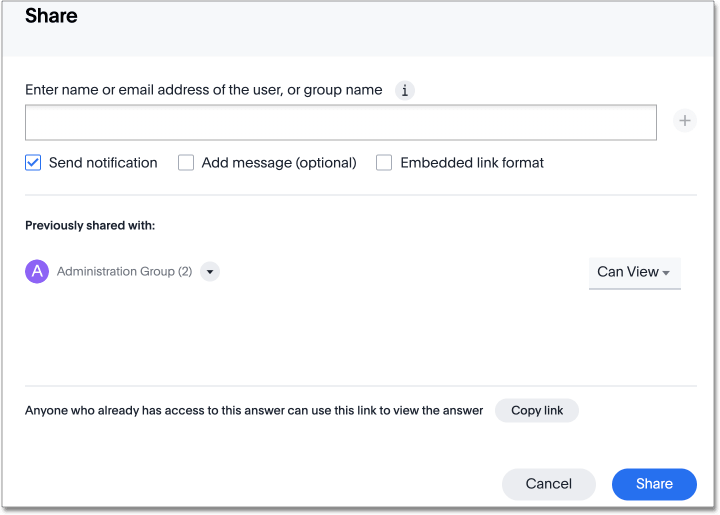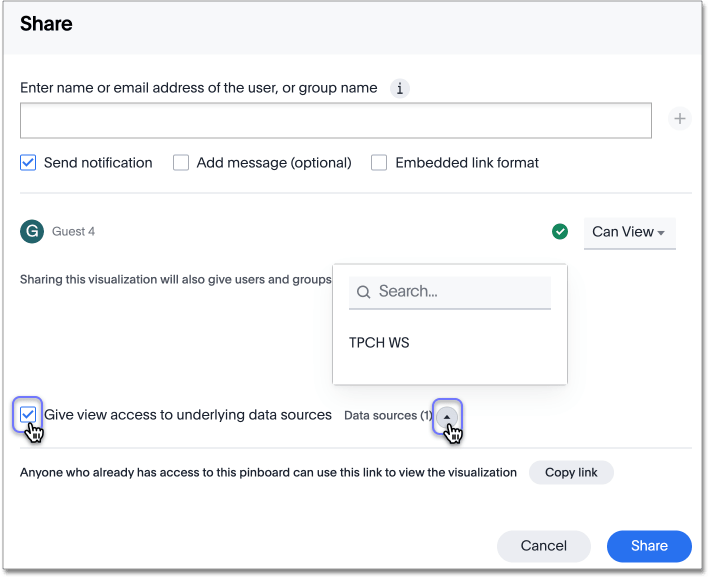When you log into ThoughtSpot, you see the ThoughtSpot home page. It is accessible when you select Home or the ThoughtSpot logo from the top navigation bar.
The ThoughtSpot home page allows you to access all your essential actions as a business user. From the home page, you can:
- Search across existing answers and Liveboards
- Search your data to create new answers and Liveboards
- Track important metrics
- View objects you viewed recently
- View trending Liveboards and answers
- Filter existing objects by favorite, author, tag, or type of object
- Sort existing objects by author, views, or most recently viewed
- Bulk mark objects as favorites
- Bulk share objects with other users and groups

Search across existing answers and Liveboards
You can search across all existing answers, Liveboards, and visualizations in Liveboards that are built on worksheets where you have access. Use this functionality if you cannot remember the exact name of a useful answer, do not remember which Liveboard a visualization is on, or if you are simply wondering if someone else already created an answer or Liveboard that would suit your needs.
The home page displays the Search answers experience by default. You can select a specific worksheet from the Sources dropdown to the left of the search bar, or search across all worksheets that you have access to. Type your query into the search bar at the top of the screen. Select Go or click Enter on your keyboard. For example, search sales in the last year bob if you are looking for a particular Liveboard about sales that your coworker Bob made. This type of search does not require you to be extensively familiar with your company’s data and how it is organized.
See Search Answers for more information on searching across existing objects.
Search your data
You can search directly on your data. Use this functionality if you would like to create your own answers and Liveboards to answer questions about your data.
To search your data, select the Search data button in the top navigation bar. The Search data page appears. Select a data source to search on, and type your query into the search bar at the top of the screen. Select Go or click Enter on your keyboard. For example, search sales last year store #103 bakery to see last year’s sales in the bakery department for store 103. This type of search requires you to be familiar with your company’s data, to know which worksheets contain data that interests you, and the names of the columns and values within that worksheet.
See Searching data for more information on searching your data.
Track important metrics
When you first view the ThoughtSpot home page, you may see a row of popular metrics for your company just below the Search bar. This watchlist may be empty, if your company is new to ThoughtSpot. Use this watchlist to view and track metrics you reference often. For example, a VP of Sales might track Number of new deals this month, while a product manager might track NPS score. You can also click on these metrics to access the Liveboard they come from, either in the same tab or in a new tab.
To add metrics to your watchlist, follow these steps:
-
Click Add metrics to your watchlist from the end of the row of existing metrics you are tracking.
You may need to use the right arrow button to get to the Add metrics to your watchlist option, if you already track several metrics. -
The Add metrics window modal appears, showing the headlines on the Liveboard you most recently viewed. To find headlines from another Liveboard you would like to add, search for that Liveboard using the search bar near the top left of the Add metrics window.
-
Select a metric or multiple metrics, and click Add metrics.
Note that you can have any number of metrics on your watchlist at a time.

You can arrange the metric cards in 2 ways:
-
Drag and drop: Move the metric cards to different positions in your watchlist using drag and drop.
-
Three-dot more
 icon: You can replace or delete a metric, move it one spot to the left or right, make a card the first one in the row, or insert another card to the right or left of a specific card.
icon: You can replace or delete a metric, move it one spot to the left or right, make a card the first one in the row, or insert another card to the right or left of a specific card.
Recently viewed
By default, the ThoughtSpot home page shows you a list of all answers and Liveboards you have access to, in order of how recently you viewed them. To view answers and Liveboards in the opposite order, click on Last viewed. Click on it again to return to the original view.
To see more objects, scroll down to the bottom of the page and select Next. ThoughtSpot displays 20 objects on each page.
This change does not persist across sessions. If you log out and log back in, the view returns to the default.
Trending Liveboards and Answers
The home page shows you the top 5 trending Liveboards and answers among all users in your environment on the right panel of the screen. You can see how many views these trending objects have. Easily view and interact with these trending objects by clicking on their name from the Trending panel. You can open them in a new tab by right-clicking on the link.
Filter existing objects
You can filter the objects that display on the home page in the following ways:
- By object type: To see only one type of object, select Answers or Liveboards from the filter bar underneath the search bar. To see both answers and Liveboards, select All.
- By tag: Users can tag their objects with meaningful labels, such as Sales or C-suite. Choose an existing tag from the tag dropdown in the filter bar. To see objects with any tag or no tag, select All tags.
- By author: To see objects created by a specific user, select an author from the authors dropdown in the filter bar. To see objects you created, select your username from the dropdown, right below All authors. To see objects any user created, select All authors.
- By favorites: To see only objects you favorited, click on the My favorites toggle on the filter bar. To see all objects, click on the My favorites toggle again.
To see more objects, scroll down to the bottom of the page and select Next. ThoughtSpot displays 20 objects on each page.
These changes do not persist across sessions. If you log out and log back in, the view returns to the default, where you see all object types, all tags, and all authors.
Sort existing objects
You can sort the objects that display on the home page in the following ways:
- Alphabetically by author: You can sort by author alphabetically, either ascending or descending. Click on Author, above the list of recently viewed objects. To see ascending order, select Author again.
- By number of views: You can sort by the number of views an object has, either ascending or descending. Click on Views, above the list of recently viewed objects. To see ascending order, select Views again.
- By how recently you viewed an object: You can sort by how recently you viewed an object, either ascending or descending. Click on Last viewed, above the list of recently viewed objects. To see ascending order, select Last viewed again.
To see more objects, scroll down to the bottom of the page and select Next. ThoughtSpot displays 20 objects on each page.
These changes do not persist across sessions. If you log out and log back in, the view returns to the default.
Bulk mark objects as favorites
To bulk mark objects as favorites, select the empty boxes next to the object names, and select Mark as favorite near the top of the page, under the metric watchlist. You can also favorite each object on the page, by selecting the empty box next to the word Name at the top left of the screen, under the filter bar. Select Mark as favorite.
Note that you cannot select multiple objects across pages. If you select an answer on the first page, and then select Next to view more objects, ThoughtSpot’s discards your selection on the first page.
Bulk share objects with other users and groups
To bulk share the objects that appear on your home page with other users and groups, follow these steps:
-
Select the empty boxes next to the names of the objects you would like to share. Alternatively, you can select each object on the page, by selecting the empty box next to the word Name at the top left of the screen, under the filter bar.
Note that you cannot select multiple objects across pages. If you select an answer on the first page, and then select Next to view and share more objects, ThoughtSpot’s discards your selection on the first page.
-
Select Share
 , above the list of objects.
, above the list of objects. -
After you click the Share icon, the sharing dialog box appears.

-
Enter users or groups with whom you want to share this object in the text box. To stop sharing with a user or group, click the x icon next to the Permissions dropdown for that user or group.
Note that you can only enter email addresses whose domains are in your list of allowed domains. These domains appear when you click on the info button
 .Tip: If you want to hide the allowed email domains for your company, or otherwise customize them, contact ThoughtSpot support.
.Tip: If you want to hide the allowed email domains for your company, or otherwise customize them, contact ThoughtSpot support. - Configure the level of access by selecting from the drop-down list. You can select:
- Can View to provide read-only access. If the user doesn’t have access to the underlying worksheet, they can only view the shared object.
- Can Edit to allow modification. Enables renaming or deleting the shared object. If a user with edit privileges modifies a shared object, the object saves their changes.
-
If the selected group or user does not have access to the underlying data, you must enable access to the worksheet, view, or table. A black warning symbol appears when you try to share with a user who does not have underlying data access. If you click on it, it tells you to enable access:

To enable access, select Give view access to underlying data sources at the bottom of the dialog box. You can click on the arrow to view the data sources.

After you enable access, the warning symbol turns into a green checkmark.
-
You can choose to send an email notification and an optional message.
-
If your ThoughtSpot environment is embedded, select Embedded link format to generate a URL for your host application context. This option allows you to ensure that the links to the object in email notifications go to the appropriate application URL.
-
You can also copy a direct link to the answer, Liveboard, or visualization within a Liveboard that you are sharing, and separately send that link to users after you share the object with them. Simply click the Copy link button at the bottom of the sharing dialog box.

- Click Share.